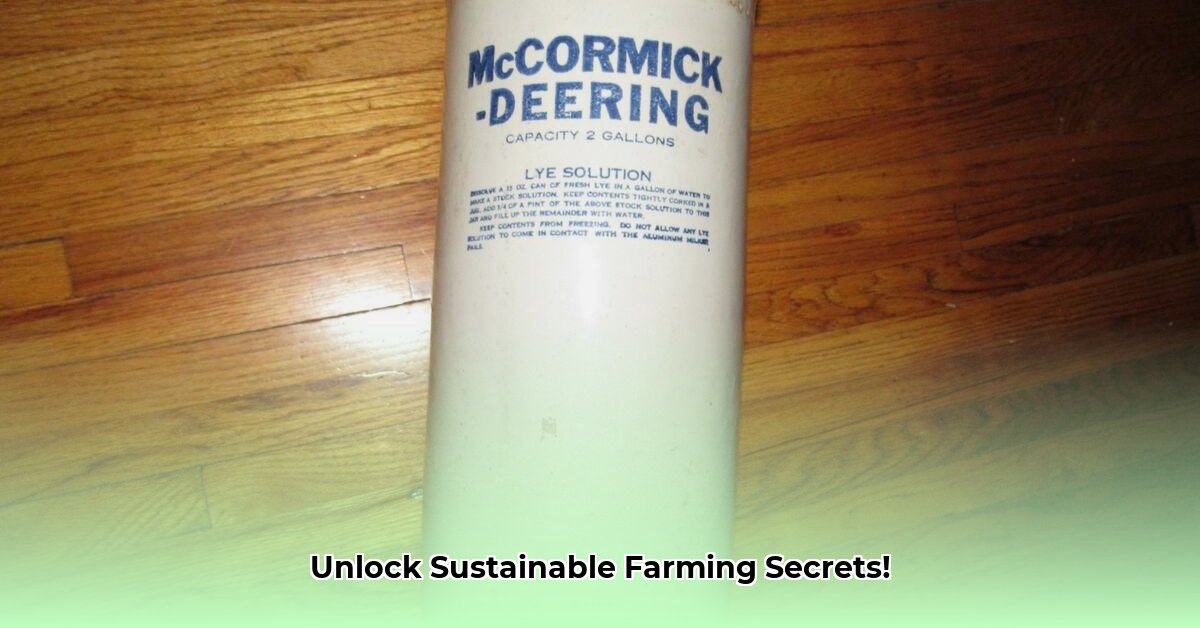
Liming your soil is a crucial step toward sustainable and productive farming. This guide provides actionable steps for effectively using agricultural lime from Tractor Supply Co. (or a similar retailer) to improve soil health and optimize crop yields. Remember, "lye" in this context refers to agricultural lime, not a harsh chemical. Always check product labels. For more information on lime from Tractor Supply, check out this helpful resource.
Understanding Soil pH and its Importance
Soil pH (a measure of acidity or alkalinity) directly impacts nutrient availability for plants. Many regions have naturally acidic soil, making it difficult for plants to absorb essential nutrients. Adding lime neutralizes acidity, making nutrients more accessible to plant roots. But how do you know if your soil needs lime?
Soil Testing: The Essential First Step
Before applying any lime, conduct a soil test. This vital step determines your soil's pH and the appropriate amount and type of lime needed. Over-liming wastes resources and can harm the environment; under-liming provides insufficient improvement. Your local agricultural extension office can provide testing services and guidance. They can interpret the results and give personalized recommendations.
Why is soil testing so important? A soil test provides data-driven solutions, preventing guesswork and ensuring efficient lime use. Dr. Emily Carter, Soil Scientist at the University of California, Davis, emphasizes, "Accurate soil testing is the cornerstone of successful lime management, preventing both over- and under-application."
Choosing the Right Lime: Calcitic vs. Dolomitic
Tractor Supply typically offers two main lime types: calcitic and dolomitic. Calcitic lime primarily contains calcium carbonate; dolomitic lime includes both calcium and magnesium carbonates. Your soil test will indicate which type best suits your soil's needs. Dolomitic lime offers the added benefit of magnesium, essential for many plants. Consult your local extension agent or a knowledgeable farmer for personalized advice—they can help you make an informed choice.
Did you know? Magnesium deficiency in plants can lead to reduced yields and compromised crop quality. Dolomitic lime addresses this by providing both calcium and magnesium.
Implementing Effective Lime Application
The application method depends on factors such as field size, soil type, budget, and farming practices.
1. Broadcasting: This even distribution method is cost-effective but may be less precise than other methods. 2. Banding: Lime is applied in narrow strips along crop rows, targeting nutrient application near plant roots. Banding offers increased efficiency compared to broadcasting. 3. Injection: This highly precise method uses specialized equipment to inject lime directly into the soil. It's typically more expensive and suited for larger-scale operations. Tractor Supply staff can offer guidance on selecting appropriate equipment and application strategies.
What is the most efficient lime application method? The efficiency of any method depends on specific soil conditions and your unique farming practices. The key is informed decision-making based on soil tests, local expertise, and your specific needs.
Timing and Safety Precautions
Lime application should be timed to allow sufficient integration into the soil prior to planting. Typically, applying lime 3-6 months before planting is recommended, allowing ample time for reactions in the soil. Avoid applying lime immediately before planting to prevent potential interference with seed germination.
Always prioritize safety when handling lime. Lime dust can irritate the eyes, lungs, and skin. Wear protective gear—including a dust mask, gloves, and eye protection—and follow label instructions closely. Safe handling ensures both your health and effective environmental stewardship.
What precautions must be taken when handling lime? Always wear appropriate protective gear, follow package instructions carefully, and consider the potential impact on surrounding vegetation and water sources. Safety is paramount.
Sustainable Soil Management: A Holistic Approach
Sustainable soil health requires ongoing monitoring. Regular soil testing, ideally every 2-3 years, or more often depending upon your specific context, facilitates data-driven adjustments to lime application. This approach ensures long-term soil health and maximizes the effectiveness of lime applications. Integrating cover cropping into your farming practices further supports soil health and biodiversity.
How can soil health be maintained long-term? A holistic approach to soil management includes regular soil testing, liming as needed, the integration of cover cropping, and awareness of your soil's specific needs.
A Sustainable Lime Application Schedule (Example)
| Task | Timing | Notes |
|---|---|---|
| Soil Testing | 6-12 months before planting | Determine lime needs and type. |
| Lime Application | 3-6 months before planting | Allow ample time for soil incorporation. |
| Planting | After soil preparation | Ensure optimal conditions for crop growth. |
| Monitoring & Re-Testing | Annually or as needed, depending on soil conditions | Regular checks for ongoing soil health management and fine-tuning lime application. |
Remember to consult your local agricultural extension office or experienced farmers for customized recommendations. Their expertise ensures your success in sustainable soil management and maximizes your farm's productivity.